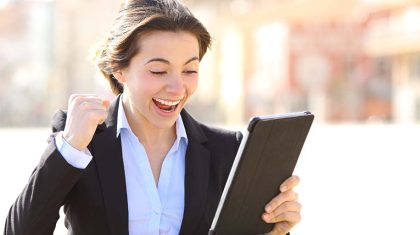
Are Digital Textbooks More Effective for K-12 Curriculum
The K-12 curriculum is increasingly being dominated by digital textbooks as educational institutes are adopting this new form of study material to teach school students. The K-12 curriculum usually comprises of courses with varying difficulty levels and complexity. As students gradually move from K to 12, their learning needs also increase.
While traditional textbooks are still a part of the educational curriculum, eBooks are rapidly becoming the preferred learning partner for students. And rightfully so, for an eBook provides much more interaction and engagement than a paperback textbook. Hence, publishers are making a move towards digital publishing to meet this growing need.
But what makes digital textbooks preferable over paperback textbooks? Surely, students must have demonstrated a liking towards eBooks or there must have been statistical evidence of students scoring better grades when learning from digital textbooks. There are many reasons as to why K-12 students must leverage digital textbooks in their learning journey; portability and cost-effectiveness being two of the major factors inspiring this change.
Why Digital Textbooks are Most Effective for K-12 Curriculum :
1. Wide Range of Digital Learning Material on a Single Device -
We know that students require more than just one textbook to prepare for their exams. Earlier, publishers used to distribute extra learning resources which students can buy and refer in order to make notes. But now, instead of providing those extra learning materials in the print format, publishers are embedding them into the eBook itself.
There are K-12 content libraries which consists of thousands of titles for students to choose from. Students can refer to the content that they feel will help them understand the concept better and score well in their tests.
So, instead of buying multiple books for the same subject, students can buy just one eBook. Moreover, a digital textbook can present content in different styles, such as infographics, videos, click and reveal images and texts etc., making learning an enriching experience.
2. Etextbooks Link to External Resources -
Today, any assignment is incomplete without a little help from search engines like Google. Students need more information. And that information is available on the web.
While it is not possible to incorporate every possible information into a printed textbook, digital publishers can include links to relevant sites from where students can find additional information. This proves helpful as students don’t have to spend time on the search engine browsing for relevant data.
3. Short Nuggets Help in Information Retention -
Bite-sized knowledge nuggets are created to help students to refresh their memory. Students have a lot of notes and study materials to go through in an academic year.
Instead of going through entire chapters all over again, these short bursts of information will help them remember the key takeaways from each chapter. They can review the lessons just-in-time before a class test or an examination.
4. Always Accessible -
Students access smartphones for around five hours a day. They spend their hours watching, reading and listening to content, or learning new stuff over the internet. By creating digital textbooks for K-12 students, you can ensure that they access their course materials anytime during the day, just like their smartphone content.
This allows them to access notes and complete assignments anywhere. Even if they forget or lose their device, they can still access the eBook by logging in from another device. Millennial students belong to the instant gratification generation, and hence, providing them with materials which they can view at their convenience leads to a better learning experience.
Related: How to Improve Student Learning Outcomes with Digital Learning
5. Cost Effective -
Students usually spend nearly $1000 per semester on textbooks. etextbooks are available at a much cheaper price than their print versions, making them affordable for students. With publishers now offering eBooks on rental subscription basis, the demand for etextbooks has risen exponentially.
As for publishers, they don’t have to face losses due to unsold physical books anymore. And with the subscription model in place, they can ensure a steady stream of revenue as students renew their subscriptions every few months or on an annual basis. Thus, digital textbooks are cost-effective not only for students but also for publishers.
Download: Can the US Higher Education Publishing Industry Leverage A Subscription Model
6. Digital Textbooks are Interactive -
etextbooks are embedded with interactive elements to keep the students engaged. Videos, images, animation, etc., are usually part of the learning modules. The different means of content delivery and presentation helps in keeping the users focused on the learning process. Video-based content is used to capture the readers’ attention and hold their interest.
Apart from multimedia elements, there are various other features that make a digital textbook interactive. Features such as bookmarking, searching, annotation, page curl, text highlight, font adjustment, etc., allow students to interact with the textbook. They can color-code their notes for visual retention, change the screen brightness and font size as per their convenience. With easy navigation and layout, a digital textbook offers better user experience.
Related: How to Create an Interactive eBook (Simple Step-by-Step Guide)
Related: 9 Benefits of Interactive eBooks
7. Digital Textbooks Enable Collaboration -
Keeping up with the social media trends, most digital reading devices are equipped with sharing features. This enables students to share notes with their peers and teachers. The sharing feature works both ways, teachers can also share notes and feedback with students online.
An eBook allows students to sync their notes across all devices such that even if they change their reading device, they can pick up where they left from. Digital natives are no strangers to sharing posts and daily activities on social platforms. Allowing them to share notes with their peers and teachers facilitates engagement and deeper comprehension of the topic and fosters collaborative learning.
Conclusion:
Educational institutes have acknowledged the growing influence of technology and are spending millions of dollars to make their institutes technology-friendly by installing new devices, purchasing software tools and LMS for smooth operations, etc. Publishers too are investing in digital publishing to provide students with feature-rich digital textbooks.
Related: 5 Ways Digital Publishers can Benefit from eBooks
The familiarity of students with smartphones has led to the rampant increase in digital textbook consumption. While a traditional textbook does offer a more personal touch as it is usually assisted with human interaction in a classroom, a digital textbook invokes more engagement on the student’s part, which helps in achieving a better learning experience. By creating eBooks for K-12 curriculum, educational institutes and publishers hope to transform the overall learning experience of students.
Discover how a mobile-first training platform can help your organization.
Kitaboo is a cloud-based platform to create, deliver & track mobile-first interactive training content.





